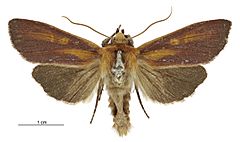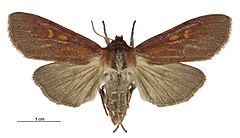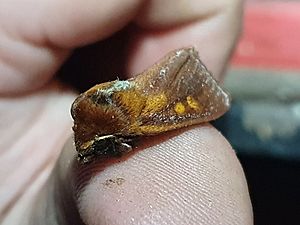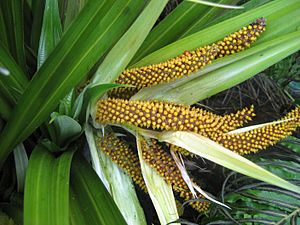Orange astelia wainscot facts for kids
Quick facts for kids Orange astelia wainscot |
|
|---|---|
 |
|
| Male | |
 |
|
| Female | |
| Scientific classification | |
| Kingdom: | |
| Phylum: | |
| Class: | |
| Order: | |
| Family: | |
| Genus: |
Ichneutica
|
| Species: |
I. purdii
|
| Binomial name | |
| Ichneutica purdii (Fereday, 1883)
|
|
| Synonyms | |
|
|
The Ichneutica purdii, also known as the orange astelia wainscot, is a type of moth. It belongs to the Noctuidae family. This moth is special because it is endemic to New Zealand. This means it is found naturally only in New Zealand.
You can find this moth all over the main islands of New Zealand. It is a fairly large and colourful moth. It is usually easy to tell apart from other moths in New Zealand. The caterpillars of this moth eat plants called Astelia at night. During the day, they hide inside the plant for safety.
When fully grown, the caterpillars can be about 48mm long. They are usually yellowish-brown with a pinkish tint and some lines. When they are ready to turn into moths, their colours change. They become a light golden colour with a rosy tint near their tail. The pupa, which is the stage before the adult moth, is a deep wine colour. It is protected inside a small cocoon. This cocoon is built under the soil, among plant bits, or inside a hollow stick. Adult moths fly from October to March. While found throughout New Zealand, they are more common in the south and at higher places, up to 1200 metres high.
Contents
Discovering the Orange Astelia Wainscot
This moth was first described in 1883 by a scientist named Richard William Fereday. He found a specimen collected by Alex. Purdie near Fairfield, Otago. Fereday named the moth Leucania purdii to honour Alex Purdie.
Later, other scientists like George Hudson studied and drew this moth. They also used the name Leucania purdii. In 1929, A. V. Chappell wrote a detailed report about the moth's life. In 1971, J. S. Dugdale moved this species to a different group, the Tmetolophota genus. He confirmed this in 1988.
In 2019, Robert J. B. Hoare did a big review of New Zealand moths. After looking closely at the original moth specimen, he placed it in the Ichneutica group. This is why its scientific name is now Ichneutica purdii.
What the Moth Looks Like
The Ichneutica purdii moth can look a bit different from one moth to another. However, you can usually spot it by its deep pink front wings. These wings have orange markings, including an orange line along the fold. The orange marks can be different lengths. The back wings of the moth are a blackish-brown colour.
Male moths have a wingspan of about 39 to 50 millimetres. Females are a little bigger, with a wingspan of 45 to 55 millimetres.
Where the Moth Lives
I. purdii is only found in New Zealand. It lives on the North, South, and Stewart Islands. You can find it from sea level up to 1200 metres high. It is more common in the southern parts of the country and at higher altitudes.
What the Caterpillars Eat
The caterpillars of this moth eat plants from the Astelia and Cordyline families. This includes plants like A. hastata and A. grandis. Scientists have also raised caterpillars on Cordyline australis in labs.
Younger caterpillars make grooves in the leaves of their host plants. Older caterpillars can eat all the way through the leaves.
Moth Behaviour
Adult Ichneutica purdii moths are attracted to light. This means you might see them near outdoor lights at night.
Life Cycle of the Moth
The eggs of the Ichneutica purdii moth are round but a bit flat. They are laid in groups. The eggs can be light blue-green, pale brown with a dark spot, or even black with a dark spot.
When the eggs hatch, the caterpillars are about 3mm long and off-white. As they grow, they become yellowish-brown with a pink tint and lines. When they are ready to change into pupae, their colours fade. They turn a light golden colour with a rosy tint at the back. The caterpillars can grow to about 48mm long.
The pupa is a deep wine colour. It is inside a small cocoon. This cocoon is built under the soil, among dead leaves, or inside a hollow stick. The adult moths fly from October to March.



